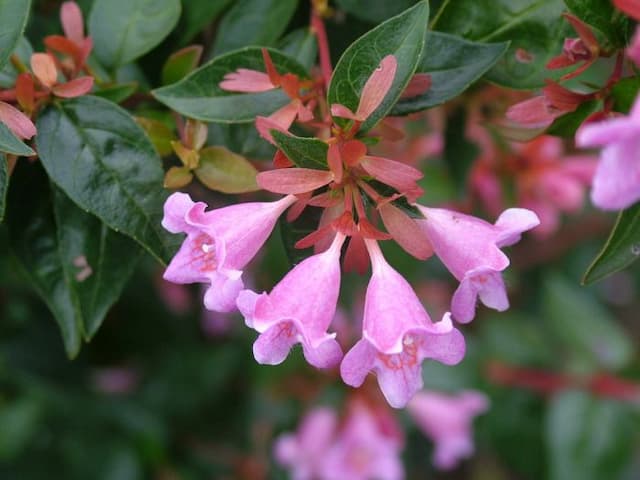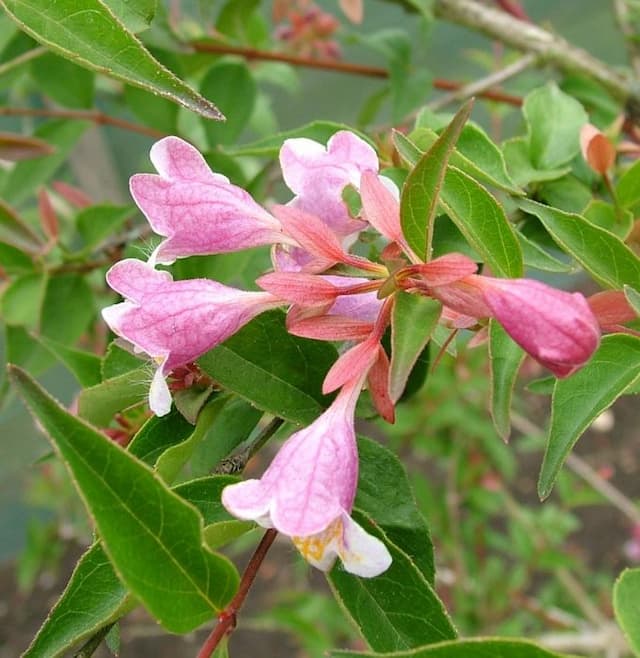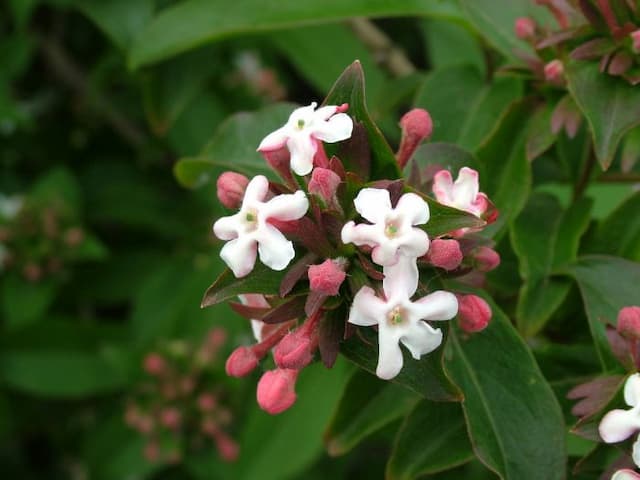Macedonian Scabious Knautia macedonica

ABOUT
Knautia macedonica, also known as Macedonian scabious, is a herbaceous perennial plant known for its unique and attractive appearance. The plant features a basal rosette of softly hairy leaves that are deeply lobed, giving them a somewhat lacy appearance. The leaves can vary in shades of green, often with hints of grayish undertones. The most striking feature of the Macedonian scabious is its flowers. These bloom atop slender, branching stems that rise above the foliage. The flowers are composed of tightly packed, small florets that create a pincushion-like effect. They usually appear in a rich shade of crimson, wine-red, or sometimes a dark pinkish-purple, providing a vivid splash of color in the garden. The bloom heads are globular and can resemble a honeycomb from a distance due to their intricate structure. The flowers of Macedonian scabious are not only visually appealing but also attract a variety of pollinators, including bees and butterflies, thanks to their nectar-rich composition. The blooming period typically occurs in the summer and can extend into the early fall, showcasing the plant's beauty for an extended season. After flowering, the plant may produce seed heads that add an additional ornamental quality to the plant, especially when covered with morning dew or frost, providing visual interest beyond the flowering season. These seed heads can persist, adding a dried flower look to the plant. Overall, Macedonian scabious can bring a touch of wild and natural charm to a garden setting with its free-flowering habit and alluring color palette that stands out beautifully against its green to grayish-green foliage.
About this plant
 Names
NamesFamily
Caprifoliaceae
Synonyms
Macedonian Scabious, Knautia
Common names
Trichera macedonica, Knautia purpurea, Knautia velutina, Knautia drymeia, Knautia longifolia, Knautia sibirica.
 Toxicity
ToxicityTo humans
Knautia macedonica, commonly known as Macedonian scabious, is not widely recognized for being toxic to humans. There are no significant reports of poisoning or adverse symptoms associated with ingestion of this plant. It is generally considered safe to handle and be around Macedonian scabious, but as with any plant, it is advisable to exercise caution and avoid ingesting plant material unless it is known to be edible.
To pets
Macedonian scabious is similarly not known to be toxic to pets. There is minimal information suggesting that ingestion of this plant causes any harmful effects in animals. As a precaution, pet owners should still monitor their pets around plants to prevent any unexpected reactions or gastrointestinal discomfort that might occur from ingesting plant material that is not part of their regular diet.
 Characteristics
CharacteristicsLife cycle
Perennials
Foliage type
Deciduous
Color of leaves
Green
Flower color
Red
Height
1-2 feet (30-60 cm)
Spread
1-2 feet (30-60 cm)
Plant type
Herb
Hardiness zones
5
Native area
Balkans
Benefits
 General Benefits
General Benefits- Attracts Pollinators: Knautia macedonica is popular among bees, butterflies, and other beneficial insects, thus promoting local biodiversity.
- Ornamental Appeal: With its striking crimson to deep pink flowers, this plant adds aesthetic value to gardens and landscapes.
- Drought Tolerance: Well-adapted to dry conditions, making it suitable for xeriscaping or gardens in arid climates.
- Easy Maintenance: It is generally low maintenance, requiring minimal care once established.
- Long Blooming Period: Flowers from early summer to early fall, providing extended visual interest in the garden.
- Deer Resistance: Generally resistant to browsing by deer, which can benefit gardeners in areas with active deer populations.
- Native Plant Promotion: Being native to the Balkan region, it can be used in gardens to promote regional flora.
- Soil Erosion Control: The plant's root system helps stabilize soil, reducing erosion in certain landscapes.
- Wildlife Habitat: Provides food and habitat for various wildlife species, contributing to a healthy ecosystem.
- Garden Design Versatility: Can be used in a variety of garden designs, including cottage gardens, prairie-style plantings, and perennial borders.
- Companion Planting: Pairs well with other perennials and grasses, enhancing overall garden design and plant diversity.
 Medical Properties
Medical Properties- This plant is not used for medical purposes.
 Air-purifying Qualities
Air-purifying QualitiesThis plant is not specifically known for air purifying qualities.
 Other Uses
Other Uses- Knautia macedonica, commonly known as Macedonian scabious, can be used in cut flower arrangements due to its striking pincushion-like flowers and a long vase life.
- In the garden, Macedonian scabious is often planted to attract butterflies and bees, making it an excellent choice for pollinator-friendly gardens.
- Some gardeners use the dried seed heads of Macedonian scabious in floral crafts and as a natural addition to rustic decor.
- Due to its deep root system, planting Macedonian scabious can help with soil stabilization in erosion-prone areas.
- Because of their lengthy blooming period, Macedonian scabious plants are sometimes used by photographers and artists seeking live models for depicting natural scenes.
- The vibrant color of Macedonian scabious can be utilized in garden design and landscaping to provide contrast with green foliage and complement other flowering plants.
- In educational settings, Macedonian scabious may be used to demonstrate plant development from seed to flower as part of biology classes.
- Macedonian scabious can be planted in meadow gardens to contribute to the creation of a natural, wildflower landscape which requires less maintenance.
- Knautia macedonica serves as a natural indicator plant for gardeners, signaling the right time for planting tender crops once it starts blooming due to its specific flowering period.
- Gardeners can use the plant to fill in gaps in perennial borders, as Macedonian scabious has a relatively compact and upright growth habit.
Interesting Facts
 Feng Shui
Feng ShuiThe Knautia macedonica is not used in Feng Shui practice.
 Zodiac Sign Compitability
Zodiac Sign CompitabilityThe Knautia macedonica is not used in astrology practice.
 Plant Symbolism
Plant Symbolism- Attraction: With its vibrant crimson flowers, Knautia macedonica often symbolizes allure and magnetism.
- Elegance: The delicate and lace-like appearance of the blooms can represent sophistication and grace.
- Unity: The cluster of small flowers that form a head can be seen as a symbol of bringing together diverse elements in unity.
- Survival: As a hardy perennial that thrives in various conditions, it can represent endurance and the ability to overcome challenges.
 Water
WaterFor Knautia macedonica, commonly known as Macedonian Scabious, the plant requires moderate watering, with an emphasis on allowing the soil to dry out slightly between waterings. Ensure consistent moisture during the growing season but avoid overwatering to prevent root rot. On average, water the plant with approximately 1 gallon per week, adjusting for rainfall and temperature conditions. During hot, dry spells, you may need to water twice a week, while in cooler, damp conditions, watering can be reduced.
 Light
LightMacedonian Scabious thrives in full sun conditions, receiving at least six hours of direct sunlight daily. The best spot for this plant is in an area with clear exposure to the sky, such as an open garden bed or border that is not shaded by trees or taller structures.
 Temperature
TemperatureMacedonian Scabious is tolerant of a range of temperatures but performs best when the weather is between 60°F and 75°F. It can withstand minimum temperatures down to around 20°F, making it suitable for many temperate climates. Avoid extreme heat above 85°F, as it may stress the plant.
 Pruning
PruningMacedonian Scabious should be pruned to remove spent flowers, which encourages continued blooming, and to maintain its shape. Deadheading regularly, especially before seeds set, will promote more flowers. Pruning can be done throughout the blooming season, and in late fall, cut back the foliage to the ground to prepare for winter.
 Cleaning
CleaningAs needed
 Soil
SoilFor Knautia macedonica, commonly known as Macedonian scabious, the ideal soil mixture is well-drained, fertile, and loamy. It should include a combination of garden soil, compost, and sharp sand to improve drainage. This plant prefers a soil pH that ranges from slightly acidic to neutral, ideally between pH 6.0 and 7.5.
 Repotting
RepottingMacedonian scabious does not typically require frequent repotting as it is most commonly grown as a perennial outdoor plant. It is best planted directly in the garden where it can spread out and does not need to be moved. Repotting is generally only necessary if the plant outgrows its container, about every 2-3 years if grown in pots.
 Humidity & Misting
Humidity & MistingMacedonian scabious is a hardy plant that adapts well to average outdoor humidity levels. It does not require high humidity environments and can thrive in the ambient humidity found in most temperate regions. Specific humidity levels are not critical for its success.
 Suitable locations
Suitable locationsIndoor
Ensure full sun and well-draining soil for Macedonian scabious.
Outdoor
Plant in full sun, well-drained soil, and space adequately.
Hardiness zone
5-9 USDA
 Life cycle
Life cycleKnautia macedonica, commonly known as Macedonian Scabious, begins its life cycle with seed germination, typically in early spring, where it requires a period of cold stratification to break seed dormancy. Once germinated, seedlings develop into a basal rosette of leaves. As temperatures warm, the rosette grows and the plant develops a branching stem system. By mid to late summer, Macedonian Scabious produces its characteristic deep red to purple flower heads atop long stems, attracting pollinators such as bees and butterflies. After pollination, flowers form seed heads, which mature and disperse seeds for the next generation. In colder climates, the plant dies back to the ground in winter, but the root system remains alive and will resprout in the following spring.
 Propogation
PropogationPropogation time
Spring to early summer
Propogation: The most popular method of propagation for Knautia macedonica, commonly known as Macedonian scabious, is via seed. Seeds can be sown directly into the garden in fall or early spring when the soil temperature reaches around 68°F (20°C). Alternatively, for an early start, seeds can be sown indoors 6 to 8 weeks before the last anticipated frost. Use a well-draining seed starting mix, and barely cover the seeds as they require light for germination. Keep the soil consistently moist but not waterlogged. Seedlings should emerge in 2 to 3 weeks, and after the frost danger has passed, young plants can be acclimatized to outdoor conditions and transplanted to their permanent positions in the garden, maintaining a spacing of around 12 to 18 inches (30 to 45 centimeters) apart.






![Himalayan honeysuckle [Golden Lanterns]](/_next/image?url=https%3A%2F%2Fplants-admin.emdemapps.com%2Fimages%2Fplants%2F%2Fimages%2F604b55302cc87.png&w=640&q=75)


